Friday essay: the politics of curry
- Written by Mridula Nath Chakraborty, Deputy Director, Monash Asia Institute, Monash University
Opening Night, Melbourne Comedy Festival 2018. Dilruk Jayasinha’s introductory salvo:
This is so exciting. I honestly… Sorry, it’s unbelievable — that I get to do stand-up comedy here at the Palais in Melbourne. Because I… I’m from Sri Lanka! And I used to be an accountant. Yeah. A Sri Lankan accountant!!! So — not just a money cruncher, but a curry-munching money cruncher!
Thaaat word … is it back again? For someone who has spent the last 30 years of her life specialising in English literary, postcolonial and cultural studies, I had never encountered it until I arrived in Australia 10 years ago and soon after chanced upon Roanna Gonsalves.
Not the real-life, award-winning writer of The Permanent Resident, but (to me, at the time) a little known author of the short story “Curry Muncher.” In Gonsalves’ story, an Indian international student working night shifts as a restaurant waiter is attacked on a Sydney train and viciously beaten up, while repeatedly being called a “curry muncher”. Like the story’s omniscient narrator/fellow-passenger/onlooker, I was genuinely puzzled as to why that term could or would exist:
I wondered how one could possibly munch curry? The way I understood it, curry, being a liquid, could be eaten with rice or one could even drink it as one did rasam and even sambhar. But there was no way one could munch curry as if it were a biscuit.
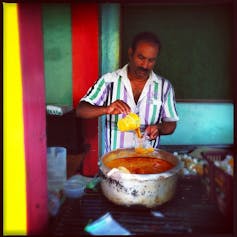 A Singaporean curry purveyor.
Jonathan Ooi/flickr, CC BY-NC-ND
A Singaporean curry purveyor.
Jonathan Ooi/flickr, CC BY-NC-ND
When “Curry Muncher” was published in Eureka Street in June 2009, in the wake of two years of intermittent protests by Indian international students and taxi-drivers against racially-motivated violence in Sydney and Melbourne, you could be forgiven for assuming that the narratorial voice was a thinly-disguised autobiographical riff. In fact, when I wanted to invite Gonsalves to participate at a university roundtable about the racist attacks, the organisers rescinded the invitation when I told them the short story was fictional - the author was not a “real life” victim of the violence.
Gonsalves has since steadfastly maintained the right of imagination to animate her fiction and has refused to inhabit the implied authentically-currified authorial body. But it seems that time and time again, stories and identities of the South Asian diaspora get emulsified in the deep pool of curry that Jayasinha too uses to flavour his circular stand-up act.
An invention of the British Empire?
Embedded in the slur curry muncher is a long history of racialised stereotyping and name-calling that accrues to bodies presumed to be the primary ingesters of that great culinary equaliser, the curry. The aspersion is collectively cast upon inhabitants of, and diasporic populations tracing their genealogy to, the Indian subcontinent, alternatively known as South Asia.
A close kin to the noun is the verb “to curry favour,” also related to “brown-nosing”, which refers to the orifice at the other end of the digestive canal that comes into contact with curry. In the hands of creatives like Gonsalves and Jayasinha, such terms are reclaimed and recuperated to make a political statement against hegemonic cultures and hate-groups that use them to essentialise, discriminate against, and terrorise subcontinental brown folk in white settler nations.
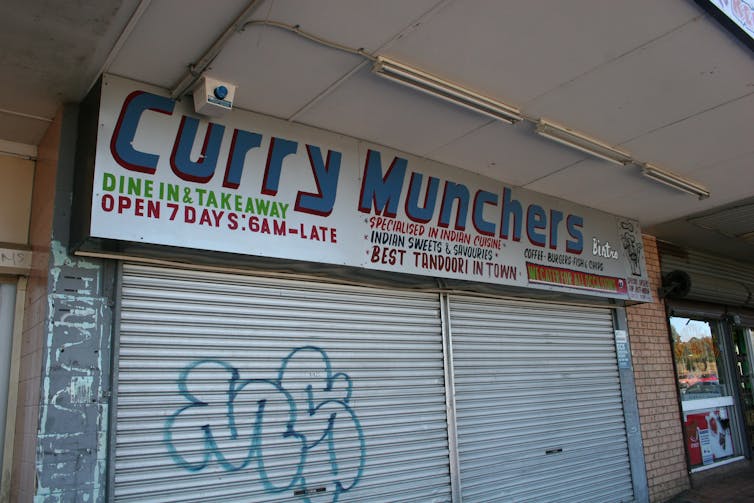 Curry is not ‘munched’ like a biscuit.
Beau Giles, flickr, CC BY-SA
Curry is not ‘munched’ like a biscuit.
Beau Giles, flickr, CC BY-SA
Notwithstanding the fact that the prefix in question is one of those enduring inventions of the British Empire that no self-respecting subcontinental would own without a thousand caveats attached, “curry” seems to be the lowest-common denominator that unites these disparate peoples who have had their histories defined by European colonisation.
Christopher Columbus might have set the action in motion in 1492 when he sallied forth to find the shortest sea-route to the Indies in search of the famed spices that Europe coveted, but really, it is the Brits who can rightfully claim to be the progenitors of the ubiquitous dish called the “curry”.
The Wikipedia entry for it traces the word as far back as the 1390s to the French (“cury” from “cuire”, meaning to cook), thence to a mid-17th century Portuguese cookbook, with the “first” English curry recipe recorded in 1747. An entire body of academic scholarship on the subject interprets the meaning of curry as domesticating imperialism, codifying race and transnationalising identity.
The eventual spread and sprawl of Anglophone colonisation took the now-popular creation to all corners of the world. Wherever the English went, taking with them slaves, soldiers, indentured labourers, bureaucrats, factotums, cooks, clerks, coolies and other cogs in the wheels of Empire, so did the curry. Curry might well say, like that T-shirt, “We are here because you were there!”
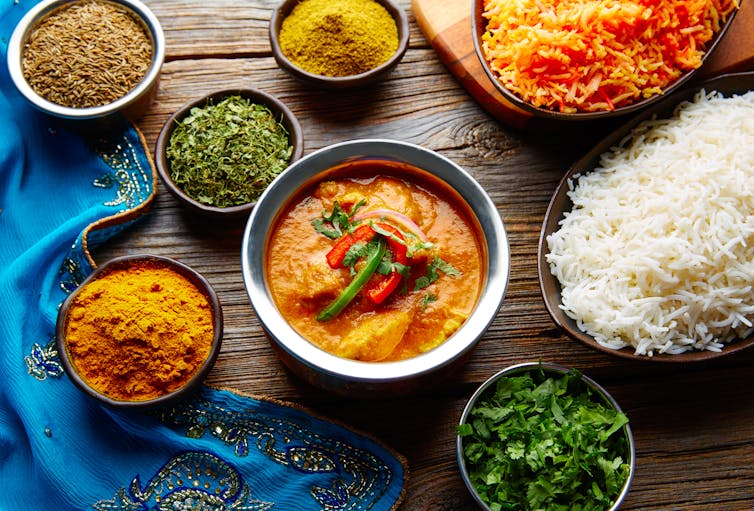 An entire body of scholarship has interpreted the meaning of curry.
Shutterstock
An entire body of scholarship has interpreted the meaning of curry.
Shutterstock
Thus in lands far away from the Indies, in the Caribbean, East and South Africa, Fiji, Guyana, the Maldives, Mauritius and Suriname, sprang up a cuisine created with local ingredients that was the closest approximation of loved and remembered foods from “back home”.
Curry then attaches both to the food and the identity of the people from which it is assumed to have originated, attaining the power of stereotype to achieve its full effect. Like the English language, the capaciousness of the culinary genre grants admission to variegated arrivants, even as the putative “custodians” of the recipes, the peoples from the Indies, are rendered unwelcome in Anglophone collectives. These migrated flocks are forever deemed to be speaking in accents, munching away at their curry, leading to that seemingly curious and innocuous, yet politically offensive and proprietorial, question: “Where are you really from?”
A potent metaphor
Still, it appears that these flotsam and jetsam of Empire’s enterprise are not content with the mulligatawny soups and kedgerees that the British brought back home to ye olde England. Subcontinentals and South Asians stubbornly insist on their “own” versions of rasams and khichuris (cousin to the Egyptian koshari). Therefore, it follows they must possess the secret magic ingredient that will lead to a truly original curry.
Paradoxically, “foreign” innovations are treated with suspicion, by the descendants of both the colonisers and the colonised, leading to that dreaded quest for the authentic experience on all quarters.
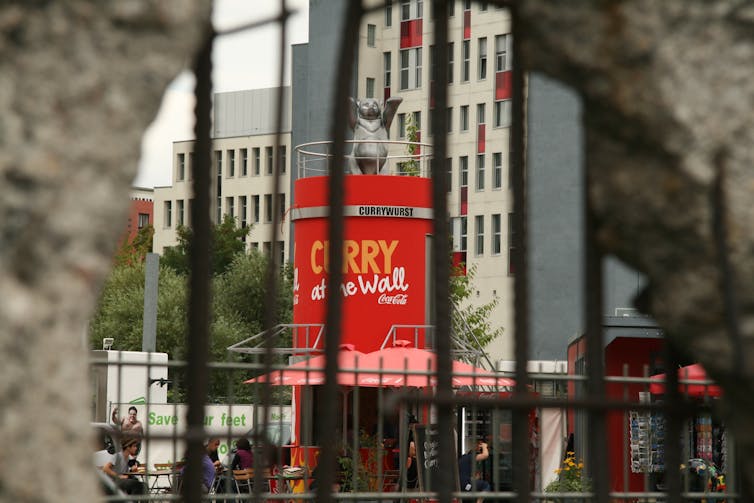 Curry at the Wall Berlin serves currywurst: a pork sausage served with curry flavored ketchup.
Claudio Saavedra/flickr, CC BY-NC-SA
Curry at the Wall Berlin serves currywurst: a pork sausage served with curry flavored ketchup.
Claudio Saavedra/flickr, CC BY-NC-SA
It is this totalising affect and effect of curry that Naben Ruthnum, a Torontonian of Mauritian descent, cavils against in his recent book Curry: Eating, reading and race. Ruthnum contends that in migrant-based, multicultural states and colonial-settler nations, subcontinental/South Asian minorities like him partake of the meaning of curry, in food and in literature, as “the defining elements” of their identity (albeit unwillingly and ambivalently).
Curry becomes a way of being contained and corralled by their own communities holding on to the fragile, frayed thread of belonging to that mythically-originary Indies, as well as creatively hybridising the changing face of a dish that has always absorbed influences.
Ruthnum is interested in the historically specific self-identifications of subcontinental diasporas. They devour, in equal amounts of delight, disbelief and disaffection, both the recipes and the curry-novels that narrativise migration journeys.
His book is divided into three sections: the executing and eating of; the reading and reflecting about, and the racialising and erasing of identity via the curry. In the first two sections, he makes a convincingly cheeky case against the insistence on the purity of curry-making and charges a polemic against the way curry-novels constantly transmute into conversations about “experience, alienation, authenticity, and belonging”.
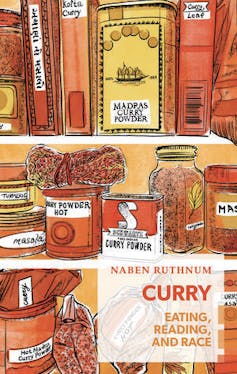 Matters get really interesting in the third section, when Ruthnum delves deep into why curry continues to provide such a potent metaphor for South Asians, forcing a kind of subcontinental solidarity on brown bodies. Such idyllic camaraderie and commensality, however, is not borne out by the entrenched divisions of subcontinental caste, class, gender and arrival stories.
For those not-in-the-know of subcontinental stratarchies at your local curry house, it may not matter whether it is paneer, chicken, mutton, beef or fish that goes into your tikka-masala. But to the initiated and adept, it is the hermeneutics of différence unto death that determines their eating practices and politics.
Tracing his own ancestry to a V. Ruthnum who arrived in Mauritius in 1886, and having discussed his own contemporary alienation of trying to find comradeship in the “colonial gangbang” of a creolised island nation, Ruthnum concludes:
Just as curry doesn’t exactly exist, neither does the diasporic South Asian. If we are attempting to build solidarity out of a shared history, it will never quite mesh, hold true, unless our great-grandparents happened to be from the same time and place… Members of Team Diaspora may have skin of the same general tone, but each has a family history that is likely completely distinct.
What Exactly is a Curry? asks Camellia Punjabi in 50 Great Curries of India where the word might mean different things in different regional subcontinental contexts: “kari”, “kadhi”, “kaari”. Mridula Bajlekar’s Curry: fire and spice includes recipes from South East Asia in its remit, while Lizzie Collingham’s Curry: A Tale of Cooks and Conquerers concludes that popular dishes now known as curries are the result of a prolonged history of invasion and fusion of food traditions from Persia to Portugal in the subcontinent.
Notwithstanding the indeterminacy and obduracy of the curry to resist definition, discussions around its “roots” continue unabated. From unflinching purists to unabashed adulterers, everyone has a position (missionary or otherwise) on the curry; the only constant being that each narrative is tied to identity and its (ab)uses. Even among proponents of un-curry, the attempt to establish bona fide credentials remains an overwhelming ambition.
Matters get really interesting in the third section, when Ruthnum delves deep into why curry continues to provide such a potent metaphor for South Asians, forcing a kind of subcontinental solidarity on brown bodies. Such idyllic camaraderie and commensality, however, is not borne out by the entrenched divisions of subcontinental caste, class, gender and arrival stories.
For those not-in-the-know of subcontinental stratarchies at your local curry house, it may not matter whether it is paneer, chicken, mutton, beef or fish that goes into your tikka-masala. But to the initiated and adept, it is the hermeneutics of différence unto death that determines their eating practices and politics.
Tracing his own ancestry to a V. Ruthnum who arrived in Mauritius in 1886, and having discussed his own contemporary alienation of trying to find comradeship in the “colonial gangbang” of a creolised island nation, Ruthnum concludes:
Just as curry doesn’t exactly exist, neither does the diasporic South Asian. If we are attempting to build solidarity out of a shared history, it will never quite mesh, hold true, unless our great-grandparents happened to be from the same time and place… Members of Team Diaspora may have skin of the same general tone, but each has a family history that is likely completely distinct.
What Exactly is a Curry? asks Camellia Punjabi in 50 Great Curries of India where the word might mean different things in different regional subcontinental contexts: “kari”, “kadhi”, “kaari”. Mridula Bajlekar’s Curry: fire and spice includes recipes from South East Asia in its remit, while Lizzie Collingham’s Curry: A Tale of Cooks and Conquerers concludes that popular dishes now known as curries are the result of a prolonged history of invasion and fusion of food traditions from Persia to Portugal in the subcontinent.
Notwithstanding the indeterminacy and obduracy of the curry to resist definition, discussions around its “roots” continue unabated. From unflinching purists to unabashed adulterers, everyone has a position (missionary or otherwise) on the curry; the only constant being that each narrative is tied to identity and its (ab)uses. Even among proponents of un-curry, the attempt to establish bona fide credentials remains an overwhelming ambition.
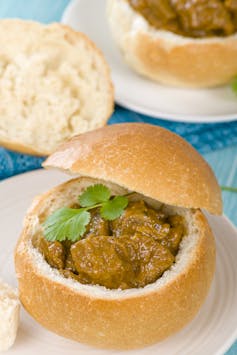 South African bunny chow.
shutterstock
In fact, the more specialised a curry is, the greater appears to be the need of practitioners and purveyors to pin down its ancestry. In the subcontinent, this might take the shape of venerating culinary traditions like the Bengali, the Kashmiri or the Saraswat. Regional subcontinental particularities like the Awadhi, the Mapila and the Parsi are but testament to the enormous trade and traffic in cultures and influences through the millennia.
Curries at a remove from the subcontinent have the constant burden placed on them to prove their authenticity, an expectation that sits piously and provocatively on migrant bodies that have swum valiantly onto unknown shores. The buss up shut roti, the bunny chow, the litti chokha give any curry a run for its money, and triumphantly declare their independence against the republic of curry.
Currying on…
Landing in Sydney in 2008 after an 18-hour flight from Edmonton, where I had lived for a decade, I was taken aback by my alarming lack of diasporic angst as the plane almost touched the red-tiled roofs of St Peter’s. Perhaps I was also lulled into a familiar/familial tropical torpor by the scent of the freesias and frangipani that greeted me everywhere.
Nestled in a tiny apartment atop Kantipur Nepali grocery store in Marrickville, I was still half a decade away from its gentrification and burgeoning foodie scene. Instead, my neighbours were a fruit shop run by two hierarchical but loquacious Greek brothers and an unbelievably clean butchery. I was charmed by the Australian language, which left nothing to the imagination as to what might transpire inside those premises: the butchery!
Nine months on, walking about in this not-yet-not-quite-hip inner-west neighbourhood, I would pass numerous verandahs where grizzled, old Greek men sat playing board games while a tiny, bearded goat munched on grass growing in the cracks between cemented front lawns. I hazarded the guess that, true to old country values, these were being fattened for Easter on the tenderest green tidbits. I also discovered that the butchery would sell you a full baby goat: I only had to convince three of my friends to go in for shares.
When I enjoined upon the laconic butcher to give each one of us a leg, the grim, unsmiling character said, without missing a beat on his cleaver: “Goat not have four legs. Cow have four legs.” Somehow that seemed wildly funny on that dazzling day as the four of us stood across from the Uniting Church and hugged our blood-soaked packages to take home and bestow the meat with our own unique benefaction.
South African bunny chow.
shutterstock
In fact, the more specialised a curry is, the greater appears to be the need of practitioners and purveyors to pin down its ancestry. In the subcontinent, this might take the shape of venerating culinary traditions like the Bengali, the Kashmiri or the Saraswat. Regional subcontinental particularities like the Awadhi, the Mapila and the Parsi are but testament to the enormous trade and traffic in cultures and influences through the millennia.
Curries at a remove from the subcontinent have the constant burden placed on them to prove their authenticity, an expectation that sits piously and provocatively on migrant bodies that have swum valiantly onto unknown shores. The buss up shut roti, the bunny chow, the litti chokha give any curry a run for its money, and triumphantly declare their independence against the republic of curry.
Currying on…
Landing in Sydney in 2008 after an 18-hour flight from Edmonton, where I had lived for a decade, I was taken aback by my alarming lack of diasporic angst as the plane almost touched the red-tiled roofs of St Peter’s. Perhaps I was also lulled into a familiar/familial tropical torpor by the scent of the freesias and frangipani that greeted me everywhere.
Nestled in a tiny apartment atop Kantipur Nepali grocery store in Marrickville, I was still half a decade away from its gentrification and burgeoning foodie scene. Instead, my neighbours were a fruit shop run by two hierarchical but loquacious Greek brothers and an unbelievably clean butchery. I was charmed by the Australian language, which left nothing to the imagination as to what might transpire inside those premises: the butchery!
Nine months on, walking about in this not-yet-not-quite-hip inner-west neighbourhood, I would pass numerous verandahs where grizzled, old Greek men sat playing board games while a tiny, bearded goat munched on grass growing in the cracks between cemented front lawns. I hazarded the guess that, true to old country values, these were being fattened for Easter on the tenderest green tidbits. I also discovered that the butchery would sell you a full baby goat: I only had to convince three of my friends to go in for shares.
When I enjoined upon the laconic butcher to give each one of us a leg, the grim, unsmiling character said, without missing a beat on his cleaver: “Goat not have four legs. Cow have four legs.” Somehow that seemed wildly funny on that dazzling day as the four of us stood across from the Uniting Church and hugged our blood-soaked packages to take home and bestow the meat with our own unique benefaction.
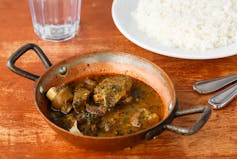 Goat curry? Moi?
shutterstock
The deal was that we would invite each other to taste our culinary creations. Among all possible renditions, roast leg of goat, goat ragout, goat chops, goat cutlets, goat shashlik and goat dumplings, it fell to me of course to make the goat curry. Moi, who bristled indignantly whenever anyone asked me what the best place to “eat Indian” was in town: hell, I’d been here only less than a year! Moreover, in a city of such culinary finesse and fusion, where every Shazza, Dazza and Bazza had access to cuisine from Vietnam to Vanuatu, Bangladesh to Beirut, China to Cyprus, why on earth was it assumed that I, fresh off the flight, would know, or even want to know, the best place to “eat Indian”?
There was a promiscuity of palate and uppity savoir faire in Sydney that I have come to love, but somehow that would get eclipsed in the quotidian query that presumed that when South Asians went out, we would consume only our own, never the “other”, that our tongues were not urbane enough for the pronunciation of, or experimentation with, other “global” foods, and that the connoisseurship afforded to aficionados who could differentiate between which wines to pair with “Indian” was not available to us.
In this field of alimentary refinement, South Asians could only ever be native informants, never enlightened anthropologists or even pretentious gourmands.
Ten years on, the question never fails to arrive: the push and pull of authenticity laid square at my door to conjure the “most genuine” Indian food possible, a parallel to those other historically amnesiac questions encountered with unfailing regularity, with inimitable rising inflections: “You really speak good English?” and “Will you stay on in ’stralia?”
These connections between being called a smelly curry muncher and pigeonholed as the genuine article or authority on “curry” cut deep, but paradoxically they are also a reminder, as Ruthnum puts it, “that there are domestic, comforting aspects to exoticism”.
Goat curry? Moi?
shutterstock
The deal was that we would invite each other to taste our culinary creations. Among all possible renditions, roast leg of goat, goat ragout, goat chops, goat cutlets, goat shashlik and goat dumplings, it fell to me of course to make the goat curry. Moi, who bristled indignantly whenever anyone asked me what the best place to “eat Indian” was in town: hell, I’d been here only less than a year! Moreover, in a city of such culinary finesse and fusion, where every Shazza, Dazza and Bazza had access to cuisine from Vietnam to Vanuatu, Bangladesh to Beirut, China to Cyprus, why on earth was it assumed that I, fresh off the flight, would know, or even want to know, the best place to “eat Indian”?
There was a promiscuity of palate and uppity savoir faire in Sydney that I have come to love, but somehow that would get eclipsed in the quotidian query that presumed that when South Asians went out, we would consume only our own, never the “other”, that our tongues were not urbane enough for the pronunciation of, or experimentation with, other “global” foods, and that the connoisseurship afforded to aficionados who could differentiate between which wines to pair with “Indian” was not available to us.
In this field of alimentary refinement, South Asians could only ever be native informants, never enlightened anthropologists or even pretentious gourmands.
Ten years on, the question never fails to arrive: the push and pull of authenticity laid square at my door to conjure the “most genuine” Indian food possible, a parallel to those other historically amnesiac questions encountered with unfailing regularity, with inimitable rising inflections: “You really speak good English?” and “Will you stay on in ’stralia?”
These connections between being called a smelly curry muncher and pigeonholed as the genuine article or authority on “curry” cut deep, but paradoxically they are also a reminder, as Ruthnum puts it, “that there are domestic, comforting aspects to exoticism”.
 Curry t shirts, Japan.
Wikimedia Commons
They are a frequent intimation of one’s provisional and privileged place in a settler nation, as well as an incantation that we might know something about that most adaptive, bastardised and chameleon-like dish of Empire, the curry, even as we wag our typhoid-yellow index fingers and wiggle our collective subcontinental heads and insist that it just does not exist.
So to go back to that day, when it came down to being objectified as a true blue, genuine cook of goat curry, I had no objections. These were my Australian friends, South Asian and non-South Asian, the ones who had taken me deep into their hearts and homes, and if curry was what they wanted, curry is what I would make them. I invoked my ancient culinary karma and sacred gastronomic inheritance to embark on the journey of the goat via my friend Iman’s Egyptian recipe that called for only onions, garlic and black peppercorns. No mustard oil, no cinnamon or cloves, no turmeric and chili, no cumin and coriander powder, or ginger and garam masala.
After all, she, no mean cook herself, had declared with supreme discernment once, when I had painstakingly made Egyptian mahshi from a recipe, that they tasted absolutely Indian, that anything I made would taste Indian. It is a fact of life I have come to embrace as well, as I go about adding green chillies to my penne pasta and soy sauce to my cauliflower curries. A right royal subcontinental flip to the Descartian dualism: cogito, ergo sum upturned into, “I am, therefore I curry!”
At 0.37 seconds in the trailer for the Netflix documentary series, Ugly Delicious, David Chang, the renowned Momofuku chef leading a crusade against purity and piety in food, has a memorable line that all authenti-siasts should adopt as their motto: “It’s when you eat a dish that reminds you of a dish cooked by your mom.”
I may improvise, with the right pinch of remembrance and matricidal rejection thrown in, curry is an invention and an inventory of arrival that also asserts its adulthood against that long-lost mother country, tongue and palate.
Ruthnum would agree that authenticity talk is uniquely boring and absorbing: the more you try to establish provenance, the more pedantic it becomes, but the conversation around it can be endlessly entertaining. As Helen Rosner, roving food correspondent at The New Yorker concludes, “the great cooks, in Chang’s view, are those who don’t just deploy an ingredient or a technique but feel it, deeply, adopting the food and its history as a fundamental part of who they are.”
This then is ultimately what is at the heart of the insistence on curry: the owning and the disavowing of it at the same time, in all its racialized legacies and imperial flavours, in all the ways that it searches for a genesis story and all the wonderful wanton ways in which it leads you astray in the detours of history.
Curry as social bonding, curry as story telling, curry as sloganeering, curry as stand-up comedy, curry as the personal, curry as the politics, curry as imagined community — keep calm and long live the curry!
Curry t shirts, Japan.
Wikimedia Commons
They are a frequent intimation of one’s provisional and privileged place in a settler nation, as well as an incantation that we might know something about that most adaptive, bastardised and chameleon-like dish of Empire, the curry, even as we wag our typhoid-yellow index fingers and wiggle our collective subcontinental heads and insist that it just does not exist.
So to go back to that day, when it came down to being objectified as a true blue, genuine cook of goat curry, I had no objections. These were my Australian friends, South Asian and non-South Asian, the ones who had taken me deep into their hearts and homes, and if curry was what they wanted, curry is what I would make them. I invoked my ancient culinary karma and sacred gastronomic inheritance to embark on the journey of the goat via my friend Iman’s Egyptian recipe that called for only onions, garlic and black peppercorns. No mustard oil, no cinnamon or cloves, no turmeric and chili, no cumin and coriander powder, or ginger and garam masala.
After all, she, no mean cook herself, had declared with supreme discernment once, when I had painstakingly made Egyptian mahshi from a recipe, that they tasted absolutely Indian, that anything I made would taste Indian. It is a fact of life I have come to embrace as well, as I go about adding green chillies to my penne pasta and soy sauce to my cauliflower curries. A right royal subcontinental flip to the Descartian dualism: cogito, ergo sum upturned into, “I am, therefore I curry!”
At 0.37 seconds in the trailer for the Netflix documentary series, Ugly Delicious, David Chang, the renowned Momofuku chef leading a crusade against purity and piety in food, has a memorable line that all authenti-siasts should adopt as their motto: “It’s when you eat a dish that reminds you of a dish cooked by your mom.”
I may improvise, with the right pinch of remembrance and matricidal rejection thrown in, curry is an invention and an inventory of arrival that also asserts its adulthood against that long-lost mother country, tongue and palate.
Ruthnum would agree that authenticity talk is uniquely boring and absorbing: the more you try to establish provenance, the more pedantic it becomes, but the conversation around it can be endlessly entertaining. As Helen Rosner, roving food correspondent at The New Yorker concludes, “the great cooks, in Chang’s view, are those who don’t just deploy an ingredient or a technique but feel it, deeply, adopting the food and its history as a fundamental part of who they are.”
This then is ultimately what is at the heart of the insistence on curry: the owning and the disavowing of it at the same time, in all its racialized legacies and imperial flavours, in all the ways that it searches for a genesis story and all the wonderful wanton ways in which it leads you astray in the detours of history.
Curry as social bonding, curry as story telling, curry as sloganeering, curry as stand-up comedy, curry as the personal, curry as the politics, curry as imagined community — keep calm and long live the curry!
Authors: Mridula Nath Chakraborty, Deputy Director, Monash Asia Institute, Monash University
Read more http://theconversation.com/friday-essay-the-politics-of-curry-97457



